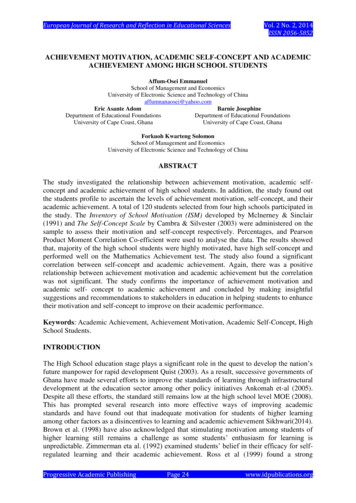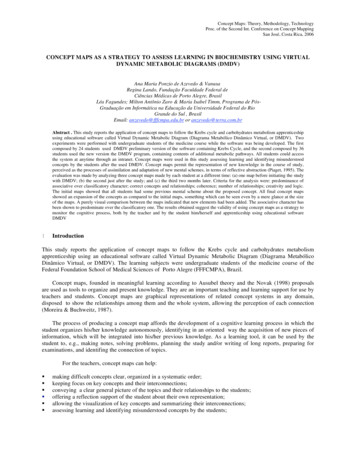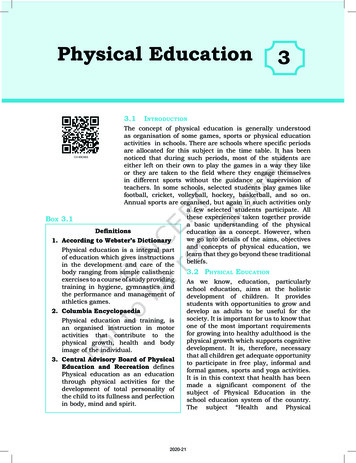
Transcription
European Journal of Adapted Physical Activity, 4(1), 38-53 European Federation of Adapted Physical Activity, 2011PHYSICAL SELF-CONCEPT AND SELF-ESTEEM IN ADOLESCENTS AND YOUNGADULTS WITH AND WITHOUT PHYSICAL DISABILITY:THE ROLE OF SPORTS PARTICIPATIONStefano Scarpa, Ph.D ** Department of Educational Sciences, University of Padua, ItalyThe present study aims to investigate the role of physical activity and sports participation onphysical self-concept and self-esteem in adolescents and young adults with and without physicaldisability. The participants were 1149 individuals aged between 13 and 28 (578 boys and 571 girls).They were divided into four groups: (A) without disability who practised sport (n 742), (B)without disability who did not practise sport (n 264), (C) physical disabled who practised sport (n 109), (D) physical disabled who did not practise sport (n 34). The participants completed thePhysical Self-Description Questionnaire (PSDQ; Marsh, Richards, Johnson, Roche, & Tremayne,1994) in a cross-sectional design. The results highlighted that individuals with physical disabilitywho practised sport obtained similar results to the people without disability who practised sport in aten of the eleven PSDQ scales. Finally it seems possible to assert that persons with physicaldisability who practise sport present a positive physical self-concept and good self-esteem.KEYWORDS: Physical Self-Concept, Physical Disability, Sport, AdolescenceINTRODUCTIONSelf-concept is one of the mostresearched constructs within the framework ofeducational psychology, psychology of thepersonality, and social psychology. Selfconcept can be defined as the perception thatan individual has of him or herself, withcontents that are both descriptive, as well asevaluative (Harter, 2003, 1999). As far as Fox(1998) affirms, self-concept refers to how anindividual perceives him or herself, or theself-described profile based on a multitude ofroles and attributes that we believe make upone’s own self. The three main characteristicsof the construct are multi-dimensionality,hierarchy, and stability. Self-concept iscomprised of various dimensions (social,physical, and academic), that pose themselvesin a hierarchical manner, in order to constructthe global self and have an influence on selfesteem. The stability of self-concept, in aglobal form, refers to the fact that it is noteasily susceptible to change (Marsh & Yeung,1998).Corporeal self-recognition constitutes acomponent of self-concept that is not easy todefine in unambiguous terms.38However, it can be affirmed that corporealself-recognition constitutes an ensemble ofknowledge,feelings,memories,andexperiences that the individual uses to refer tohis or her body (Fox, 1998). Physical selfconcept is considered a multidimensionalsubdomain of the overall self-concept thatincorporates different characteristics, such asphysical activity, fitness conditions, healthand appearance (Marsh, Richards, Johnson,Roche, & Tremayne, 1994). It should be alsomentioned that Fox and Corbin (1989)suggested the multidimensional organizationof the physical self (sport competence,physical condition, body attractiveness andphysical strength) and the role of physicalself-worth as mediator between thesedimensions and self-esteem. According toFox (1990) and Marsh (1994), themultidimensionalandhierarchicalcharacterization of physical self-concept canbe represented by a three level model withself-esteem at the top, global physical selfconcept at the second level, and specificcomponents of physical self-concept at thethird level.EUJAPA, Vol. 4, No. 1
ScarpaThe role of sports participationIn the field of sport and exercise, physicalself-conceptisalsoconsideredapsychological construct with an impact onphysical activity. It plays a considerable rolein determining results (Carraro, Scarpa, &Ventura, 2010).Scientific evidence shows that physical selfconcept is 'built' by the individual in e of three main components,i.e. somatic, psychological and socialcomponents. The development of physicalself-concept is not influenced only by the datawhich attest an individual’s physicalstructure, or only by the mere psychological,emotional and affective vision of one’sphysicality, but by the close interaction ofthese two components with the socialdimension (Cash, Thériault, & Annis, 2004;Shapiro & Martin 2010a).Physical self-concept plays a crucial roleduring adolescence and youth. In these phasesof life, individuals experience many changesin their body. Sex differences become evidentand boys achieve higher performance levels inmost physical skills (Fletcher & Hattie, 2005;Harter, 2003, 1999). During adolescence andyouth it is very important to have a positivephysical self-concept in order to promoteindividual well-being (Maїano, Ninot, &Bilard, 2004).Some studies showed that children and youngadults with disabilities have fewer friends,experience more loneliness and are moreteased and/or neglected compared to thosewithout disabilities. Furthermore, individualswith disabilities often receive negative‘feedback’ related to their body, whichcontributes to the development of a poor bodyimage (Arbour, Latimer, Martin Ginis, &Jung, 2007; Martin, 2006; Martin & Mushett,1996; Martin & Smith, 2002). Individualswith physical disabilities generally have amore negative physical self-concept thanother people, but people with physicaldisability involved in regular sports practisecan report higher levels of physical self thansedentary individuals without disability(Ferreira & Fox, 2008).39As reported by Martin in a recent congress,some sentences typical of people withphysical disability are the following: “Mydisability makes my body look bad”, “Well,my disability certainly makes me feel lessattractive. I mean, if you’re in a wheelchair,you won’t have a great body with tonedmuscles” (Martin, 2010).Indicated below, in an analytical manner andin chronological order, are the results and theimplications of the study that was conductedin the past few years regarding the role ofsports and adapted physical activities increating self-concept and, more in general, thedimensions of psychological well-beingcorrelated to such, in individuals withphysical disabilities.Campbell (1995) conducted a study with thescope of evaluating the differences inpsychological well-being among individualsin wheelchairs with congenital and acquireddisabilities who participate in a sport.Psychological well-being was evaluatedthrough points relevant to humor, generalizedanxiety, self-esteem, and sense of mastery.According to this study, athletes inwheelchairs with acquired disabilities later intheir lives present a better state of well-beingthan those with congenital disabilities.Blinde & McClung (1997) tried to evaluatethe impact of participating in recreationalactivities on the perception of physical selfconcept and social self-concept in individualswith physical disabilities. The analysis of theinterviews conducted in the study of the tworesearchers showed that participating inrecreational activities, such as swimming,fitness, tennis, and so on, has an impact onfour factors of corporeal self-recognition: (a)experimenting one’s own body in new ways;(b) increasing the perception of one’s ownphysical attributes; (c) redefining one’s ownphysical capacities; (d) increasing theconfidence perceived in facing new physicalactivities.The contribution given by Groff & Kleiber(2001) intended to verify the belief accordingto which participating in sports is tied todeveloping the identities of adolescents withEUJAPA, Vol. 4, No. 1
ScarpaThe role of sports participationphysical impairments. The results of the studyshowed that adapted sports contribute toimproving the perception of one’s ownabilities and skills, as well as emotionalexpression, and social attractions, whiledecreasing the perception of a disability.Tasiemski, Kennedy, Gardner, & Blaikley(2004) studied the development of the athleticidentity in individuals with spinal lesions. Inanalyzing the results of their study, theauthors suggest that the lowest athleticidentity related by athletes with spinal lesionscould be attributed to social evaluations thatseem not to justify the conditions of thephysically disabled individual as an athlete.Ferreira & Fox (2008), in their study,proposed analyzing multiple aspects ofphysical self-perception in male basketballplayers with and without disabilities. Inparticular, the results of the study showed thatplaying sports while in a wheelchaircontributed to a positive development ofphysical self-esteem, further furnishing aunique opportunity to successfully performcomplex sports activities. The sports contextresulted as being extremely important forindividuals with disabilities, assisting them infinding opportunities to experiment with newchallenges, evaluate their own capabilities,gain confidence and a positive vision of theirown corporeality, as well as experimentsuccessful situations when exposed to socialevaluations.Athleteswithphysicalimpairments who participated in sportsactivities, therefore, had greater confidencetowards their own bodies, a greater sense ofattraction, and a positive opinion with respectto the abilities of their bodies in their sportsperformance.Recognizing the growing importance ofadapted sports for individuals withdisabilities, the objective of the Anderson(2009) study was that of using the constructof symbolic interactionism for examining thedevelopment of the identities of adolescentgirls with physical disabilities whoparticipated in forms of organized sports inwheelchairs, with particular reference to thestudy of development of the athletic identity.40The results of the study showed a role ofprimary importance in the participation inrecreational activities, such as sports fordeveloping personal identity.Shapiro & Martin (2010a) examined theathletic identity, the loved ones, and therelations among equals in young athletes withphysical disabilities. The results of the studyshowed that friendships created within andwithout sports for the disabled can contributeto improving the quality of life, andpromoting positive emotional states, such as asense of joy, satisfaction, inspiration,excitement, and enthusiasm.In the same year, Shapiro & Martin (2010b)published a study with the scope of describingthe multi-dimensional self-concept (example:strength, resistance, and skills in sports) inathletes with physical disabilities. Among themain results, what was emphasized was thatthe perception of physical self-recognition inthe participants determined their general selfesteem for at least 50%. The other 50% couldprobably be attributed to other dimensions ofself-concept (academic, emotional, social). Ofextreme relevance seemed to be the areasrelated to flexibility, strength, and resistance,with a strong influence on general selfconcept. In summary, the results of the studyshowed that participants with a more positiveconcept of their corporeal self-recognition, aswell as of their strength, resistance, andflexibility, also demonstrated greater selfesteem with respect to those who hadobtained lower points for these four variables.Sport practice can contribute to developing apositive physical self-concept in persons withphysical disabilities (Arbour, et al., 2007).Sport can have a positive effect on thephysical self-concept of people with physicaldisabilities, not only improving their physicalcondition (e.g. increased strength andendurance) and their psychological well-being(e.g. decreased anxiety and depression,increased self-esteem and self-efficacy), butalso creating opportunities for meaningfulsocial interactions - e.g. increased socialsupport and friendship, (Blinde & McClung,1997; Campbell, 1995; Martin, 2006; Martin,& Smith, 2002).EUJAPA, Vol. 4, No. 1
ScarpaThe role of sports participationThe present study aimed at investigating therole of sport participation for the developmentof physical self-concept in individuals withphysical impairment. In particular we hadthree aims: (1) to describe physical selfconcept in adolescents and young adults (agedbetween 13 and 28) with physical disability(only one previous study investigated themultidimensional physical self-concept inadolescent and young athletes; Shapiro &Martin, 2010b), (2) to analyze the differencesbetween individuals with disability andindividuals without disability (a previousstudy investigated this point in a sample ofadult individuals; Ferreira & Fox, 2008), (3)to analyze the differences between individualswho regularly practice sport (1/1.5 hours forsession, 2/3 times at week) and individualswho do not practice any sport (there are noprevious studies investigating point 2 andpoint 3 in adolescents and young adults).Therefore, the objectives of this study werethose of analyzing the multiple aspects ofphysical self-concept in a sample ofadolescents and young adults between theages of 13 and 28 and comparatively analysisthe four groups divided on the basis of theinteraction of the variables regarding “sportsperformance” (yes/no) and the “presence ofphysical disabilities” (yes/no).Based on the rationale existing in theliterature, we hypothesize that adolescents andyoung adults with physical impairment showlower levels of perceived physical self thantheir peers without disability. We alsohypothesize that adolescents and young adultswho regularly practice sport present higherlevels of physical self-concept than their peersthat are not involved in sport activities.Finally, we hypothesize that adolescents andyoung adults with physical impairment whoregularly practice sport present similar levelsof physical self-concept than their peersinvolved in sport activities that are withoutdisability.METHODSParticipantsA convenience sample was engaged in thepresent study. The eligibility criterion for the41sport groups was the regular practice of sportfor one year or more (1/1.5 hour for session,2/3 times at week). The eligibility criterionfor the participation of disabled people wasthe presence of peripheral (spinal cordinjuries) or central (cerebral palsy) paraplegia.The eligibility criterion for the whole samplewas being aged between 13 and 28. In thisstudy, it was decided not to only consider theadolescent stage, since nowadays “youth” isintended as that stage of life, which extendsthe times of non-autonomy and nce. This is why the concept of “longadolescence” is largely used. We assist in theparadox where society obligates us to maturein an accelerated manner, on one hand, whileon the other, it does not allow for solidifyingthe identity of a youth. Social andpsychological studies show three mainelements that lead to an extension of theyouth stage in contemporary westernsocieties: the extension of the period ofschooling; the constant increase ofprofessional and economic precariousnessafter having terminated school studies; theextension of the period of time continuedliving at home (Cavalli & Galland, 1996).If up until a decade ago the “youth” categorycould be easily opposed to the “adult”category, since the transition threshold thatseparated them was clear-cut and easilyidentifiable, today, we can assist in a breakageof this traditional opposition and theestablishmentof multiple typesofintermediate situations, which cannot beeasily ‘categorized’, and that are uncertain,ambiguous, and do not allow classification ofan individual within the categories ofadolescence and adulthood. Recognizing thisobjective limit, it is possible to relate the“youth” attribute to a broad and diversifiedage range (Milan, 2001): pre-adolescence (1114 years), adolescence (15-18 years), andyouths (19-25 years and beyond).So, one thousand two hundred twenty-fivevolunteers were recruited in the present study.After data collection, out of the 1225participants, 76 had to be excluded from theanalyses because they did not meet theEUJAPA, Vol. 4, No. 1
ScarpaThe role of sports participationeligibility criteria or there were data missingfrom their questionnaires. Thus, 1149individuals (578 boys and 571 girls)participated in the study (mean age 19.03).They were divided into four groups: (A)without disability who practiced sport (n 742; 378 boys and 364 girls), (B) withoutdisability who did not practice sport (n 264;99 boys and 165 girls), (C) physicallydisabled who practiced sport (n 109; 84boys and 25 girls; 103 with spinal cordinjuries and 5 with cerebral palsy), (D)physical disabled who did not practice sport(n 34; 17 boys and 17 girls; 30 with spinalcord injuries and 4 with cerebral palsy).As can be noted by the numeric distributionof the four groups, at a first glance, thereseems to be a disproportion. That is, thenumber of non-disabled individuals isdecidedly greater than that of disabledindividuals. However, is this disproportionreal or not? If reference is made to theprinciples that are at the foundation ofsampling strategies, what is emphasized isthat the disproportion is inverse. For betterclarification, with respect to the population ofreference, which our sample wants torepresent, disabled individuals are relativelygreater in number, or better proportioned,than non-disabled individuals. According to acensus conducted by the ISTAT (ItalianNational Institute of Statistics), there are2,615,000 disabled individuals in Italy, ofwhich 1,200,000 with a physical type ofdisability. Among those with physicaldisabilities, the estimate is of 50,000paraplegics in Italy who are, above all,comprised of individuals under the age of 30.If you take into consideration that there are60,000,000 number of Italian citizens, thisimplicates that paraplegics constitute .08 % ofthe population. In other terms, there is oneparaplegic every 1,200 Italian citizens. Torespect this proportion, we would have had torecruit 1,200 non-disabled individuals foreach disabled individual. As is evident in thedata, the number of non-disabled individualsis not 1,200 times greater than that of disabledindividuals. Therefore, it is possible to sustainthat participants with disabilities present in42our sample are more than representative. Withregards to non-disabled individuals, it can beconsidered that a number approximate to onethousand is more than sufficient for thestatistical analysis to be conducted and,therefore, for meeting the objectives that wereestablished in the study.Lastly, it must be specified that, the fact thatthe number of disabled individuals whoperform sports activities is lower than thosewho do not, constitutes a limit in this study.This was tied to the difficulty in recruitingdisabled individuals for research who werenot inserted in integrated contexts of life,since the population of the number of nonparticipants is greater with respect to thosewho participate in sports. However, thisaspect will be elaborated on in the finalsection of the article, where the limits andfuture prospects of the research are explained.MeasuresPhysical Self-Description Questionnaire(PSDQ) – PSDQ was developed and validatedby Marsh et al. (1994) to assess nine specificfactors of physical self-concept and twoglobal scales, placed at a higher hierarchicallevel: physical self-concept and self-esteem.In the present study we used an Italian versionof the instrument, which is designed tomeasure the nine specific components ofphysical self-concept (activity, endurance,strength, flexibility, coordination, sport,health, body fat, appearance) and the twoglobal components (global physical andglobal esteem) in a sample of 951 students(548 female and 403 male) aged between 11and 36. Internal consistency and reliabilitywas tested using as average Cronbach’s Alpha .87 and the relevance of existing indicesreported by Scarpa, Gobbi, Paggiaro, &Carraro, 2010 revealed a good adjustment ofthe original model to the Italian populationwith RMSEA .053, NFI .965, NNFI .972, CFI .975, GFI .874, AGFI .852,PGFI .744. The invariance cross gender andage was also tested.In the sample of the present study, Cronbach'sAlpha scores for the eleven PSDQ scales wereconsidered adequate (α .73-.89, in the wholeEUJAPA, Vol. 4, No. 1
ScarpaThe role of sports participationsample, α .72-.89, in the group ofparticipants without disability, α .76-.92, inthe group of participants with physicaldisability). Exploratory Factor Analyses(EFA) was used to test the model in the groupwith physical disability. Kaiser-Myer-Olkin(KMO) was adequate (.915). The elevenfactors of the PSDQ explained 73.44 % of allvariance in the items. Factors loadings forPSDQ items was acceptable for the elevenscales: activity (.67-.88); endurance (.51-.76);strength (.59-.64); flexibility (.48-.76);coordination (.39-.77); sport (.59-.71); health(.73-.77); body fat (.88-.91); appearance (.62.74); global physical (.58-.75); global esteem(.34-.63). The scores of factors loadings forPSDQ items seemed to confirm the factorstructure and to make it possible to assumethat the model structure would be similar inthe group of individuals with physicalimpairment.After the administration of the PSDQ,participants were asked to report someessential personal information such as theirgender, age, weight (kg), height (m), kind ofsport, type of physical disability (peripheral orcerebral paraplegia).ProceduresParticipants completed the PSDQ in a crosssectional design. Participants completedquestionnaires individually and they werereassured that they responses would remainconfidential. The treatment of all participantswas in accordance with the ethical standardsof the APA. Written consent was obtainedfrom all participants and participant’ parents(in the case of minor participants).In order to ensure that PSDQ was appropriatefor the two groups of disabled people, 7people with physical disability were consultedin the pre-research stage. For example, thesentence of the sixth item (“I can run a longway.”) was changed with the followingsentence: “I can cover long distances.”.The research was carried out through theentire Italian territory, with the support ofseveral students from the degree course inPhysical Activity and Sport Sciences of theUniversities of Padova and Urbino. With43regards to non-disabled participants, studentswere involved who attended middle schools,high schools, and degree courses in PhysicalActivity and Sport Sciences, PrimaryEducation, Medicine, and Surgery from thetwo Italian universities stated above. Inrelation to disabled participants, all paraplegicassociations in Italy were contacted(personally, by phone, or by e-mail).Furthermore, particular attention was given toourresearchconductedonthe‘www.superando.it’ website, which added thequestionnaire to a web page set up with theexplanation of the research, along with thepossibility to fill out the questionnaire andsend it to the researchers.Statistical analysisAll analyses were performed using SPSS(version 18.0). Coefficient Alpha wascalculated for each of the 11 scales on thePSDQ. Descriptive statistics (mean andstandard deviation) were performed in orderto describe physical self-concept in the fourgroups. The analysis of variance (one-wayANOVA) with a post-hoc test (Bonferroni)was conducted to examine the differencesbetween the four groups on the PSDQ scales.The multivariate analysis of variance(MANOVA) was conducted to examine theinteractions between the four groups andother independent variables (gender, age; kindof impairment: spinal vs cerebral; sport type:individual vs team) on the PSDQ scales.Linear regression analysis was conducted toassess the influence of physical activity(independent variable) on global physical(dependent variable) both in individuals withphysical impairment and in individualswithout disability.RESULTSDescriptive Statistics and Analysis ofVarianceDescriptive statistics of age, weight (kg),height (m) are presented in Table 1 for eachgroup.Table 2 contains the descriptive statistics forthe PSDQ variables. Analysis of variance(Table 3) showed significant differencesEUJAPA, Vol. 4, No. 1
ScarpaThe role of sports participationbetween groups in the following PSDQscales: activity (F3,1145 350.2, p .0001),endurance (F3,1145 67.7, p .0001), strength(F3,1145 34.4, p .0001), flexibility (F3,1145 13.3, p .0001), coordination (F3,1145 52.3,p .0001), sport (F3,1145 117.6, p .0001),health (F3,1145 6.4, p .0001), body fat(F3,1145 16.1, p .0001), appearance (F3,1145 4.6, p .003), global physical (F3,1145 18.1, p .0001), and global esteem (F3,1145 20.1, p .0001).Table 1 Description of the sample (age, weight, height)ND-SPORT ND-NoSPORT D-SPORT D-NoSPORTn 742VariableMean SDn 264MeanAge (years) 17.03 4.5417.76Weight (kg) 55.35 13.2055.39Height (m)1.66 .101n 109SDn 34Mean SD MeanSD4.99 19.83 4.62 19.014.7111.99 65.77 13.49 61.65 15.231.64.102 1.70 .1321.61.173Note. ND-SPORT not disabled who practiced sport; ND-NoSPORT not disabled who did not practicesport; D-SPORT physical disabled who practiced sport; D-NoSPORT physical disabled who did notpractice sport.Table 2 Descriptive Statistics for PSDQ Scales in the four GroupsND-SPORT ND-NoSPORT D-SPORT D-NoSPORTn 742Scalen 264Mean SDMeann 109n 34SD Mean SD MeanSDActivity4.4 1.21.91.04.1 1.31.9Endurance4.1 1.32.91.44.2 1.23.0 1.4Strength4.0 1.23.31.24.3.93.2 1.3Flexibility3.8 1.23.41.23.9 1.03.0 1.2Coordination4.4.93.8.94.0 1.03.0 1.1Sport4.5 1.03.31.24.4.92.7 1.3Health5.3.85.11.05.0 1.04.7 1.3Body Fat4.9 1.34.41.44.3 1.64.0 1.8Appearance4.1 1.13.91.14.2 1.03.7 1.1Global Physical4.6 1.34.11.24.4 1.23.7 1.3Global Esteem4.74.4.94.94.0 1.3.8.7.9Note. ND-SPORT not disabled who practiced sport; ND-NoSPORT not disabled who did not practicesport; D-SPORT physical disabled who practiced sport; D-NoSPORT physical disabled who did notpractice sport.44EUJAPA, Vol. 4, No. 1
ScarpaThe role of sports participationTable 3 Analysis of Variances for PSDQ Scales in the four GroupsScaleANOVAdfFActivityEffectpSize350.23, 1145 .0001.479Endurance67.73, 1145 .0001.151Strength34.43, 1145 .0001.083Flexibility13.33, 1145 .0001.034Coordination52.33, 1145 .0001.121117.63, 1145 .0001.2366.43, 1145 .0001.01716.13, 1145 .0001.0414.63, 1145.003.012Global Physical18.13, 1145 .0001.045Global Esteem20.13, 1145 .0001.050SportHealthBody FatAppearanceNote. Effect size was calculated using the quadratic r index (95% CI).Bonferroni Post-Hoc ResultsThe Bonferroni post-hoc analysis revealedthat group A (not disabled - sport) scoredhigher than group B (not disabled – no sport)and group D (disabled – no sport), but did notdiffer from group C (disabled – sport) in thefollowingPSDQscales:endurance,flexibility, coordination, sport, appearance,global physical and global esteem. It alsoindicated that group C (disabled – sport)scored higher than group A (not disabled sport) in the strength PSDQ scale and thatgroup D (disabled – no sport) got the lowestscores of all in the coordination, sport, andglobal esteem PSDQ scales.Multivariate Analysis of VarianceThe results of the MANOVA indicated nosignificant interaction between independentvariables on the PSDQ scale, with theexception of flexibility when consideringgender differences. Female participants were45significantly more flexible thanparticipants (F1,1147 2.7, p .043).maleLinear regression analysisLinear regression analysis highlights a subtlebut significant influence of physical activityon global physical in both physicalimpairment group (Coefficient .31;Standard Error .02; t 10.5; R2 .15; F1,141 30.7; p .0001) and without disabilitygroup (Coefficient .39; Standard Error .05;t 5.5; R2 .09; F1,1003 109.2; p .0001).DISCUSSIONThe purposes of this study were to describethe participants’ physical self-concept, toassess the differences between disabled andnon-disabled groups and to analyze the role ofsports participation on physical self-concept.Comparison between the four groupssupported the hypothesis that adolescents andyoung adults who regularly practice sportpresent higher levels of physical self-conceptEUJAPA, Vol. 4, No. 1
ScarpaThe role of sports participationthan their peers who are not involved in sportsactivities and that adolescents and youngadults with physical impairment whoregularly practice sport present similar levelsof physical self-concept than their peersinvolved in sport activities that are withoutdisability.The internal consistency of the PSDQ scaleswas good for the whole sample, both for thenon-disabled group and for the disabledgroup, as shown by Cronbach's Alpha scores.Results from EFA supported the validity ofthe Italian version of the PSDQ when usedwith people with physical disability.Descriptive statistics showed that group A(non-disabled - sport) and group C (disabled –sport) had moderate to strong self-conceptscores (Shapiro & Martin, 2010b), whereasgroup B (not disabled – no sport) and group D(disabled – no sport) had lower self-conceptscores than the other two groups (with theexception of health scale for ‘not disabled –no sport’ group). A visual examinationindicates that group B (not disabled – nosport) and group D (disabled – no sport) hadthe lowest score in the physical activity scale(M 1.9). Participants who practiced sporthad moderate to strong self-concept scores asthey ranged from slightly under 4 to over 5 onthe 6-point scale. Participants withoutdisability who practiced sport had the lowestscore for flexibility (i.e., 3.8) and the highestfor health (i.e., 5.3). Similarly, participantswith physical impairment who practiced sporthad the lowest score for flexibility (i.e., 3.9)and the highest for health (i.e., 5.0). Finally, avisual examination of the descriptive statisticsindicates that group C (disabled – sport) hadhigher mean scores than group A (nondisabled - sport) in endurance (i.e., 4.2),strength (i.e., 4.3), flexibility (i.e., 3.9),appearance (i.e., 3.9), global esteem (i.e., 4
the global self and have an influence on self-esteem. The stability of self-concept, in a global form, refers to the fact that it is not easily susceptible to change (Marsh & Yeung, 1998). Corporeal self-recognition constitutes a component of self-concept that is not easy to define in unambiguous terms. However, it can be affirmed that .










